Across the Frontier into Eden*
- Lisbeth
- Site Admin
- Posts: 65822
- Joined: Sat May 19, 2012 12:31 pm
- Country: Switzerland
- Location: Lugano
- Contact:
Re: Across the Frontier into Eden
We had chosen to stay in a rondavel because of the waterhole, but I must admit that it was rather too small. The view on the waterhole was great though and it was great to sit on terrace watching the animals coming and going.
"Education is the most powerful weapon which you can use to change the world." Nelson Mandela
The desire for equality must never exceed the demands of knowledge
The desire for equality must never exceed the demands of knowledge
-
Duke
Re: Across the Frontier into Eden
It was a CH2/4 Chalet (Chalet 2BD + DSC) Mel. Good view but not of the waterhole.
The video was taken at Rooidam
The video was taken at Rooidam
-
Sharifa
Re: Across the Frontier into Eden
Thanks PJL, Lisbeth, Mel, nan, Pumbaa 
Envy you PJL for being able to go to Addo whenever you feel like it
History of Addo
References:
1. Scott Ramsay, Year in the Wild
2. Information Map you get when booking in
Addo was born from a very tragic and violent history. In the 1700’s settlers moved into the area and hunted the abundant wildlife they encountered. In 1879 and 1853 the last lion and rhino respectively were shot. The Addo bush was also being decimated. It was used to stoke the kilns of expanding brick making business. This resulted in further loss of habitat for the wildlife.
By 1918 there were no more than 140 elephants left near Addo. Here the elephants hid away in the dense spekboom, a rubbery, near impenetrable succulent bush that grows prolifically in the area. The elephants melt and disappear silently into the spekboom, which incidently grows to the same height as the elephants.
Surrounded by citrus farms the elephants had nowhere to go and found the orange orchards very tempting and juicy to ignore. At night they would emerge from the spekboom and raid the crops.
The angry farmers petitioned the government to kill the elephants and Major PJ Pretorius was contracted to shoot the elephants. Between 1919 and 1920 he shot about 114 elephants. In one hunt he shot and killed 22 elephants in just a few minutes. At the end of the macabre year there were only 16 elephants left.
The public finally woke up to the tragedy, but it was another decade before the authorities acknowledged the need to save the Cape elephant.
In 1931 Addo Elephant National Park was proclaimed. The few remaining elephants were chased into the area but it was not fenced so the elephants kept returning to the farms and came into conflict with the farmers again and again, further reducing the numbers to 11.
Another 23 years passed before Warden Graham Armstrong developed a unique fencing system of railway sleepers and Otis lift cables, unbreakable by elephants. It is called the Armstrong fence.
Finally elephants had a safe haven, safe from the guns of hunters and angry farmers. For the next few decades the elephants still feared or hated anything that smelt like a human. They would hide in the spekboom during the day or chase people and overturn cars when they could.
They say an elephant never forgets but thankfully the elephants of Addo have forgiven us for hunting and hurting them. The more than 650 elephants mingle peacefully between the tourist cars.
Although Addo was about saving the elephants it is today all about conserving the biomes and their animals and plant species. Key animals to conserve are the flightless dung beetle, the black rhino and the disease free Cape buffalo. Then there is the remarkable plant, the spekboom. Besides giving the elephants a safe haven, its medicinal value and the ability to sequester carbon from the atmosphere, it’s able to sustain high concentrations of animals, including elephants.
Elephants love spekboom! It is full of water, has a high protein and vitamin content and, unlike savannah trees and bushes it grows back very easily after it has been browsed. Even if a branch has been broken and left on the ground it can result in a new plant. It is not just the elephants that love this wonderful plant. The Black Rhino hide within the spekboom bushes during the day and 60% of the buffalo’s diet is made up of the spekboom. The antelopes and especially the kudu are thriving on spekboom diet as well.
These thriving herbivores make a space for happy predators. Lions and spotted hyenas were introduced and are doing very well. Six lions were introduced from KTP and the numbers have risen to twenty two. The eight spotted hyenas introduced from Kruger have grown to twenty. Addo is separated into sections by fences, public roads and the highway. The main section has most of the game but there are activities like hiking, fishing, horseback riding, etc. in other areas too.
The mountains of Zuurberg are one of the oldest wilderness areas in Africa. It can only be reached by horseback or hiking.
The coastal Woody Cape section’s lush temperate forest abuts the Alexandria dune field, the largest in the southern hemisphere. The protected offshore St.Croix and Bird Island are home to critically endangered African Penguins and Cape Gannets.
From trying to save the elephant on a small patch of land, Addo has become a sanctuary for a wide variety of species of plants and animals. The spekboom, cycads, yellowwood trees, Black Rhino, Dung Beetles, Great White Sharks and Southern Right Whales
The legendary Hapoor


We are ready for our game drive at 5.55 AM the next morning

It is light at 5.00 AM in Summer and we suggested that SANP look at opening the camp gate at 5.00 AM
We decide we going to drive the whole of Addo this morning, right till the Matyholweni Gate and back, to get a feel for the place.
Warthog
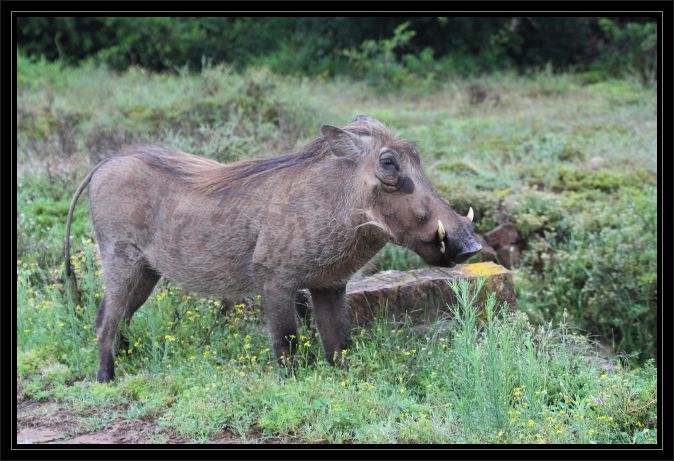
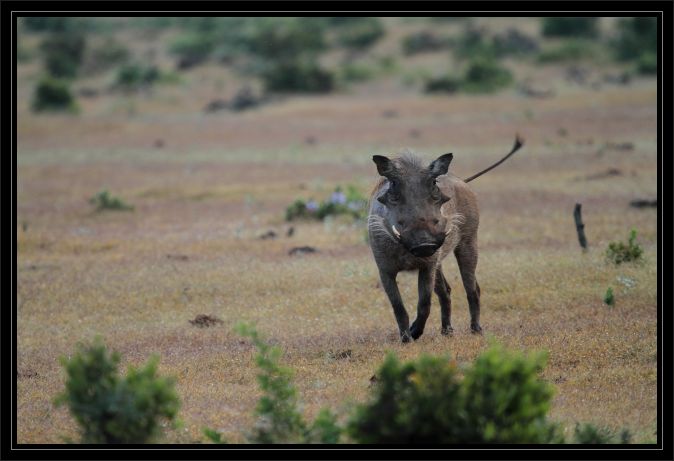
Jackal cured up on the road
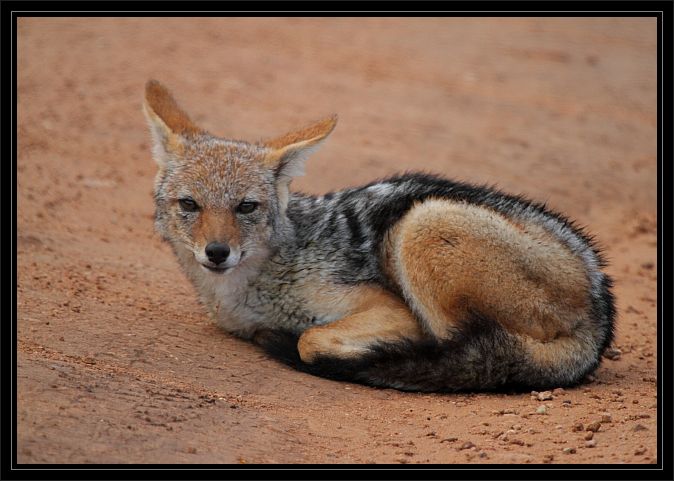
Kudu


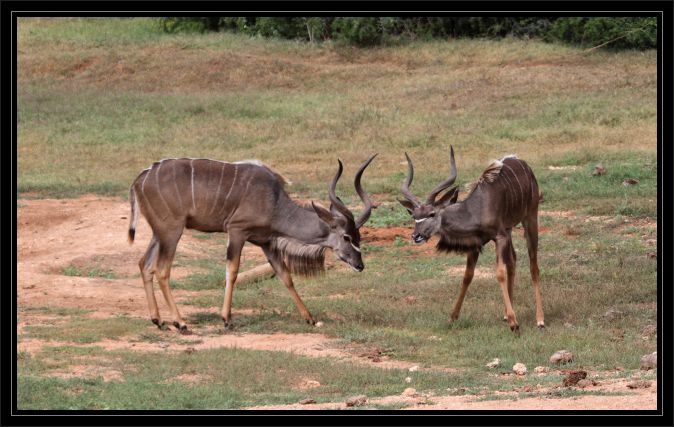
Steppe Buzzard
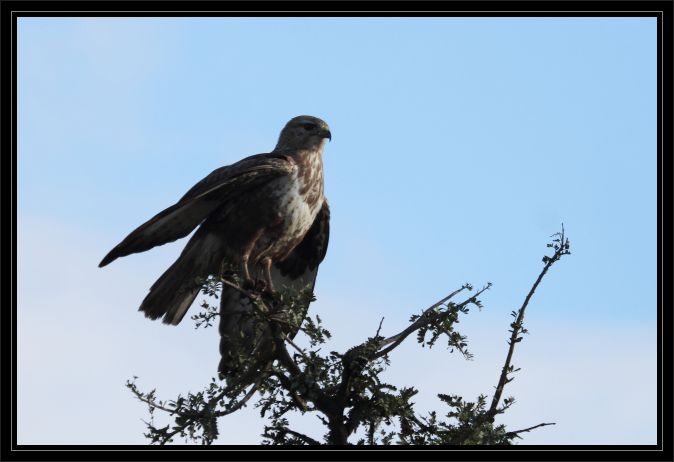

We had taken the Mbyoti Loop down and then then the Vukani Loop back north. As we hit the main road again we get a good sighting at a waterhole that is not named or marked on the map
Envy you PJL for being able to go to Addo whenever you feel like it
History of Addo
References:
1. Scott Ramsay, Year in the Wild
2. Information Map you get when booking in
Addo was born from a very tragic and violent history. In the 1700’s settlers moved into the area and hunted the abundant wildlife they encountered. In 1879 and 1853 the last lion and rhino respectively were shot. The Addo bush was also being decimated. It was used to stoke the kilns of expanding brick making business. This resulted in further loss of habitat for the wildlife.
By 1918 there were no more than 140 elephants left near Addo. Here the elephants hid away in the dense spekboom, a rubbery, near impenetrable succulent bush that grows prolifically in the area. The elephants melt and disappear silently into the spekboom, which incidently grows to the same height as the elephants.
Surrounded by citrus farms the elephants had nowhere to go and found the orange orchards very tempting and juicy to ignore. At night they would emerge from the spekboom and raid the crops.
The angry farmers petitioned the government to kill the elephants and Major PJ Pretorius was contracted to shoot the elephants. Between 1919 and 1920 he shot about 114 elephants. In one hunt he shot and killed 22 elephants in just a few minutes. At the end of the macabre year there were only 16 elephants left.
The public finally woke up to the tragedy, but it was another decade before the authorities acknowledged the need to save the Cape elephant.
In 1931 Addo Elephant National Park was proclaimed. The few remaining elephants were chased into the area but it was not fenced so the elephants kept returning to the farms and came into conflict with the farmers again and again, further reducing the numbers to 11.
Another 23 years passed before Warden Graham Armstrong developed a unique fencing system of railway sleepers and Otis lift cables, unbreakable by elephants. It is called the Armstrong fence.
Finally elephants had a safe haven, safe from the guns of hunters and angry farmers. For the next few decades the elephants still feared or hated anything that smelt like a human. They would hide in the spekboom during the day or chase people and overturn cars when they could.
They say an elephant never forgets but thankfully the elephants of Addo have forgiven us for hunting and hurting them. The more than 650 elephants mingle peacefully between the tourist cars.
Although Addo was about saving the elephants it is today all about conserving the biomes and their animals and plant species. Key animals to conserve are the flightless dung beetle, the black rhino and the disease free Cape buffalo. Then there is the remarkable plant, the spekboom. Besides giving the elephants a safe haven, its medicinal value and the ability to sequester carbon from the atmosphere, it’s able to sustain high concentrations of animals, including elephants.
Elephants love spekboom! It is full of water, has a high protein and vitamin content and, unlike savannah trees and bushes it grows back very easily after it has been browsed. Even if a branch has been broken and left on the ground it can result in a new plant. It is not just the elephants that love this wonderful plant. The Black Rhino hide within the spekboom bushes during the day and 60% of the buffalo’s diet is made up of the spekboom. The antelopes and especially the kudu are thriving on spekboom diet as well.
These thriving herbivores make a space for happy predators. Lions and spotted hyenas were introduced and are doing very well. Six lions were introduced from KTP and the numbers have risen to twenty two. The eight spotted hyenas introduced from Kruger have grown to twenty. Addo is separated into sections by fences, public roads and the highway. The main section has most of the game but there are activities like hiking, fishing, horseback riding, etc. in other areas too.
The mountains of Zuurberg are one of the oldest wilderness areas in Africa. It can only be reached by horseback or hiking.
The coastal Woody Cape section’s lush temperate forest abuts the Alexandria dune field, the largest in the southern hemisphere. The protected offshore St.Croix and Bird Island are home to critically endangered African Penguins and Cape Gannets.
From trying to save the elephant on a small patch of land, Addo has become a sanctuary for a wide variety of species of plants and animals. The spekboom, cycads, yellowwood trees, Black Rhino, Dung Beetles, Great White Sharks and Southern Right Whales
The legendary Hapoor


We are ready for our game drive at 5.55 AM the next morning

It is light at 5.00 AM in Summer and we suggested that SANP look at opening the camp gate at 5.00 AM
We decide we going to drive the whole of Addo this morning, right till the Matyholweni Gate and back, to get a feel for the place.
Warthog


Jackal cured up on the road

Kudu



Steppe Buzzard


We had taken the Mbyoti Loop down and then then the Vukani Loop back north. As we hit the main road again we get a good sighting at a waterhole that is not named or marked on the map
- Mel
- Global Moderator
- Posts: 26737
- Joined: Sat May 19, 2012 12:31 pm
- Country: Germany
- Location: Föhr
- Contact:
Re: Across the Frontier into Eden
Thanks for the revision of the elephant history, Sharifa! Up to this day I find it amazing that the Addo ellies have turned out such gentle and adorable animals,
considering the violence they had to go through and considering their ability to pass on knowledge from generation to generation.
Addo is a wonderful place!
considering the violence they had to go through and considering their ability to pass on knowledge from generation to generation.
Addo is a wonderful place!
God put me on earth to accomplish a certain amount of things. Right now I'm so far behind that I'll never die.
- PJL
- Posts: 2803
- Joined: Mon Jan 13, 2014 10:12 am
- Country: South Africa
- Location: Port Elizabeth
- Contact:
Re: Across the Frontier into Eden
Lovely photos Sharifa 

I particularly like the one of the Steppe Buzzard taking off



I particularly like the one of the Steppe Buzzard taking off
I've been trying to work out the Addo lion family tree a bit recently, as for a number of years there weren't many helpful updates about numbers and movement of the lion. When I get a chance I'll try post something about it, but the quick version is that at the moment there are 14 lion in Addo: 9 in the main game area, 2 in the Kuzuko concession and 3 in the Nyathi area. 2 of the females in the main game area are now no longer on contraception so there's a hope that there could be some cubs born in the park again sometime soonSharifa wrote:Six lions were introduced from KTP and the numbers have risen to twenty two.
Sounds intriguing... can't waitSharifa wrote:As we hit the main road again we get a good sighting at a waterhole that is not named or marked on the map
-
Sharifa
Re: Across the Frontier into Eden
Two lionesses are making their way to the waterhole just as we get there

They have hardly settled down and a little jumbo arrives and then another jumbo- not so friendly and gentle towards the cats Imagine being a KTP cat and then one morning waking up in Addo, which is lush and dense Speckboom, and then seeing Ellies
Imagine being a KTP cat and then one morning waking up in Addo, which is lush and dense Speckboom, and then seeing Ellies 



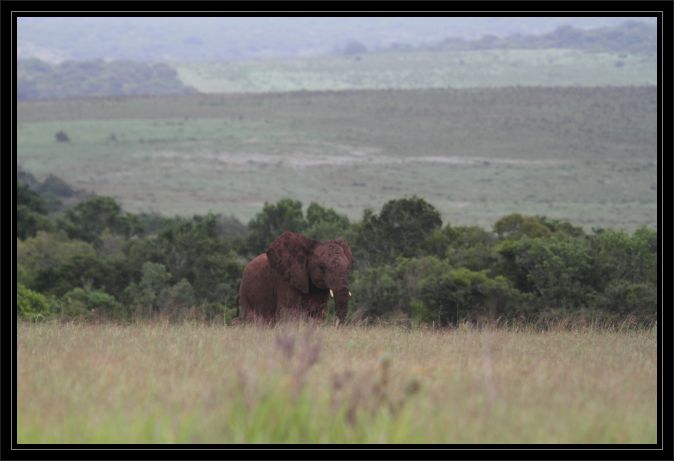

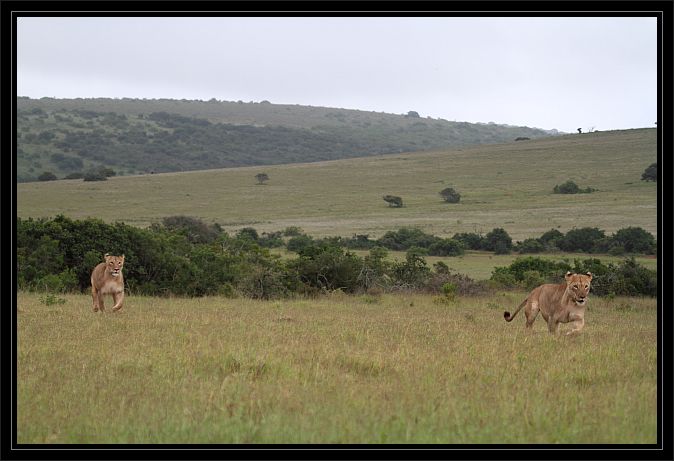
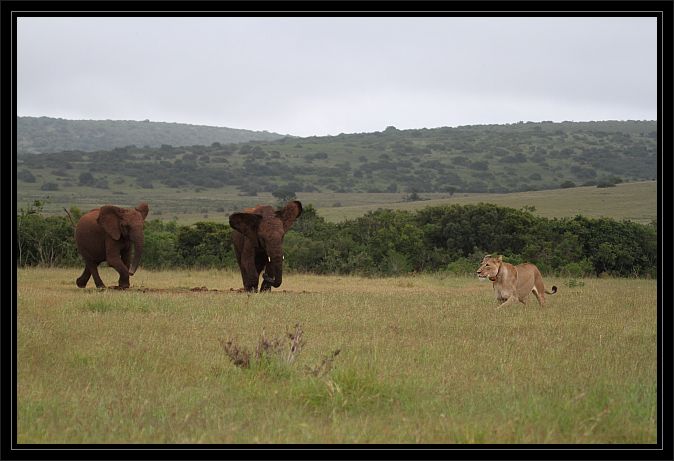
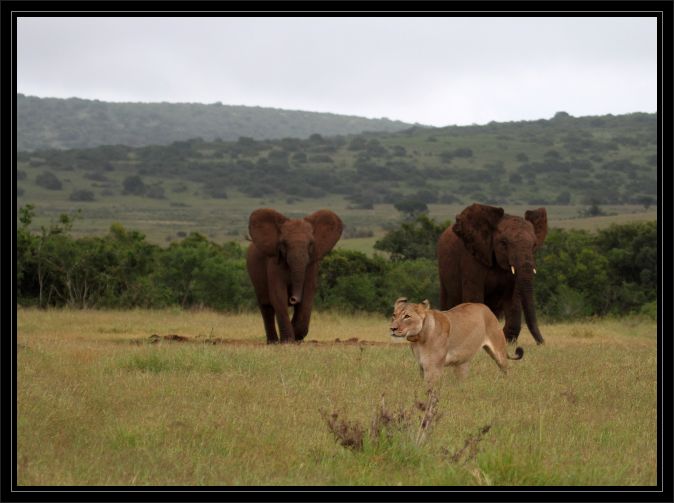
One crossed the road and disappeared and the other sat down besides us in the grass


They have hardly settled down and a little jumbo arrives and then another jumbo- not so friendly and gentle towards the cats






One crossed the road and disappeared and the other sat down besides us in the grass

- PJL
- Posts: 2803
- Joined: Mon Jan 13, 2014 10:12 am
- Country: South Africa
- Location: Port Elizabeth
- Contact:
Re: Across the Frontier into Eden
Wonderful interaction between the elephant and lion - great photos as well! 

The lioness who sat down next to you is Gina, whilst Josie is the other who ran off into hiding
They've been hanging out together quite a bit recently. Josie is one of Gina's offspring born back in 2008.
It's great that you got to see lion so soon into your trip

The lioness who sat down next to you is Gina, whilst Josie is the other who ran off into hiding
They've been hanging out together quite a bit recently. Josie is one of Gina's offspring born back in 2008.
It's great that you got to see lion so soon into your trip
-
Sharifa
Re: Across the Frontier into Eden
The Ellies were just passing through and the lionesses were soon back at the waterhole


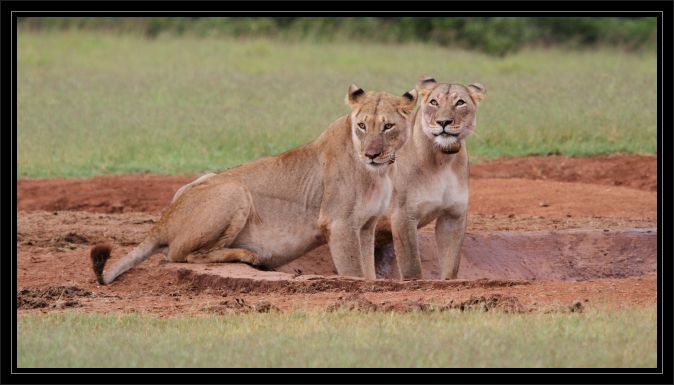
Hey, that is my head you got there
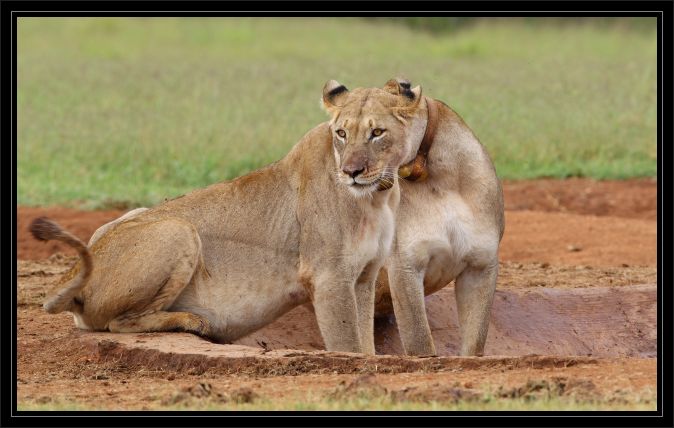
Then they moved off
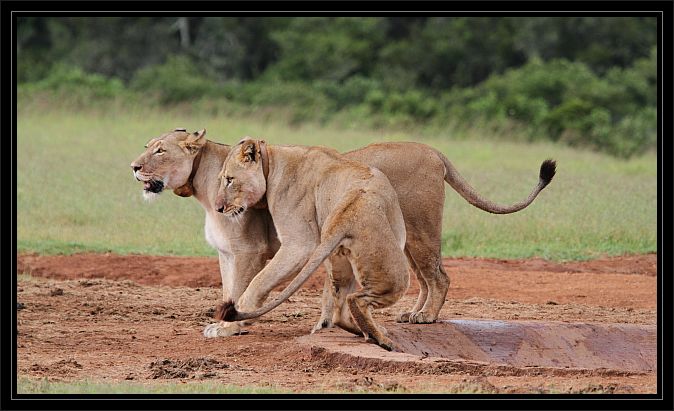
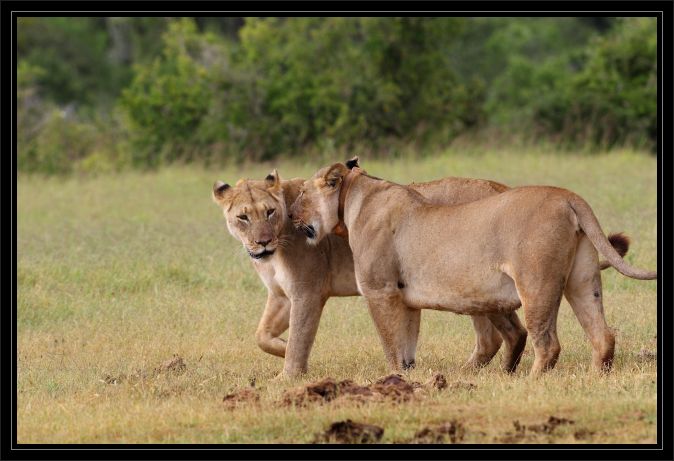
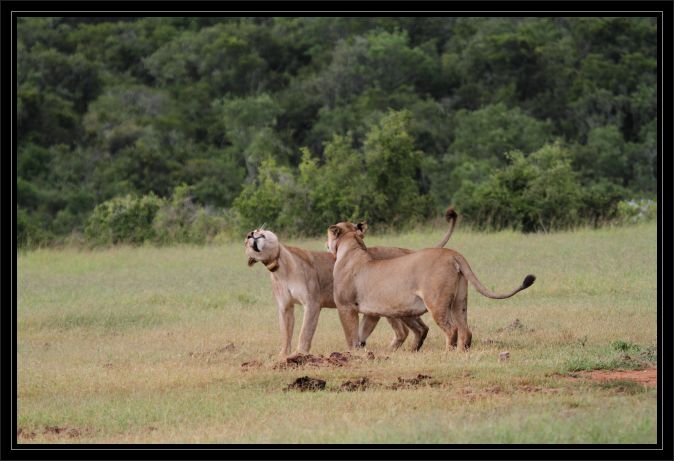



Hey, that is my head you got there

Then they moved off



- PJL
- Posts: 2803
- Joined: Mon Jan 13, 2014 10:12 am
- Country: South Africa
- Location: Port Elizabeth
- Contact:
Re: Across the Frontier into Eden
Awesome photos of the 2 girls. You can see from the big bellies and blood stains on the sides of their faces that they had eaten fairly recently 

It is a bit of a shame that the females in Addo are collared, but they have needed to know where they are for contraceptive reasons.nan wrote:and both are collared... I have to open my eyes
- PJL
- Posts: 2803
- Joined: Mon Jan 13, 2014 10:12 am
- Country: South Africa
- Location: Port Elizabeth
- Contact:
Re: Across the Frontier into Eden
It could be that they're after a bit of added protection that they each give each other as they can sometimes have a tough time from the hyena. Also possible that one or both of them is pregnant. Gina started hanging out with her mom Kamkwa back in 2008 prior to Josie, Norman & Zwaai being bornMel wrote:Wonder when Gina and Josie started to hang out together and why.
Maybe Gina felt a bit lonely after her boys went their own ways.



